The vaccination rate among children is stagnating, as reported by the World Health Organization (WHO) and UNICEF. Compared to the pre-pandemic level in 2019, 2.7 million additional children worldwide are not or only inadequately vaccinated.
Nearly three in four young children live in countries where low vaccination coverage leads to measles outbreaks. “The latest trends show that in many countries, far too many children remain unvaccinated,” said UNICEF Executive Director Catherine Russell. “Closing the vaccination gap will require a global effort, with governments, partners and local leaders investing in primary health care and community workers to ensure every child is vaccinated and health services are strengthened.”
Measles vaccination as a problem
The data also show that vaccination rates against measles have stalled, leaving nearly 35 million children unprotected or only partially protected. In 2023, according to the WHO, only 83 percent of children worldwide received their first dose of the measles vaccine as part of routine health care, while the number of children receiving their second dose increased slightly compared to the previous year, reaching 74 percent of children. “These figures are not enough to achieve the 95 percent vaccination rate needed to prevent outbreaks, avoid unnecessary illness and deaths, and achieve measles elimination goals,” the release said. In Austria, too, the measles vaccination rate is insufficient: 84 percent of two-year-olds receive the first partial vaccination, while only 74 percent receive the second.
My themes
For your bookmarked topics
new articles found.
info By clicking on the icon you add the keyword to your topics.
info
By clicking on the icon you open your “my topics” page. You have of 15 keywords saved and would have to remove keywords.
info By clicking on the icon you remove the keyword from your topics.
Add the topic to your topics.
Source: Nachrichten




